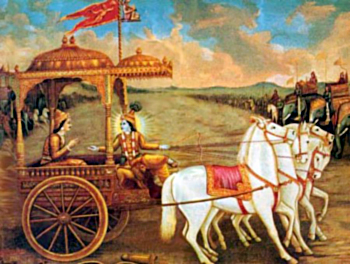 Literary style of Mahabharata is a mix of different ancient systems and techniques. As regards the language, style and metre, the various parts of the Mahabharata do not show much uniformity. It is in only quite a general sense that one can speak of "epic Sanskrit" as the language of the popular epics. In reality the language of the epic is in some parts more archaic, i.e. more closely related to the ancient Indian of the Vedic prose works, than in other parts. Moreover, apart from the linguistic phenomena which recall the Pali, there are certain solecisms which are seen to have been committed by uneducated and inferior authors like the Purana composers.
Literary style of Mahabharata is a mix of different ancient systems and techniques. As regards the language, style and metre, the various parts of the Mahabharata do not show much uniformity. It is in only quite a general sense that one can speak of "epic Sanskrit" as the language of the popular epics. In reality the language of the epic is in some parts more archaic, i.e. more closely related to the ancient Indian of the Vedic prose works, than in other parts. Moreover, apart from the linguistic phenomena which recall the Pali, there are certain solecisms which are seen to have been committed by uneducated and inferior authors like the Purana composers.
Even in the matter of style of composition of the Mahabharata, it can only be said in a general sense to be far removed from the so-called `Kavya style` i.e., the style of the later ornate poetry, which is characterised by the excessive use of embellishments (Alamkaras). However, there is no lack of passages in the Mahabharata which are reminiscent of this Kavya style. Beside these, there are also certain portions in the great epic which retain the naive style of the old Itihasas, as they are related in the Brahmanas and Upanishads, while again in numerous other portions the most negligent Purana style prevails.
As regards the metre, the Sloka which originated in the old Anustubh is certainly the metre par excellence. But there are earlier and later forms of this Sloka, which are all represented in the Mahabharata. Moreover, the epic also contains old prose passages, in which the prose is occasionally rhythmical, and sometimes alternates with verses. Also of the Tristubh metre which is often used In the Mahabharata, though the Sloka is about twenty times as frequent as the Tristubh, one can find the ancient form, still similar to the Vedic form, as well as later forms, and even the elaborate metres of classical poetry in Sanskrit literature are already to be found in certain parts of the Mahabharata.
Thus given above is a brief glimpse into the literary style of the Mahabharata.



















